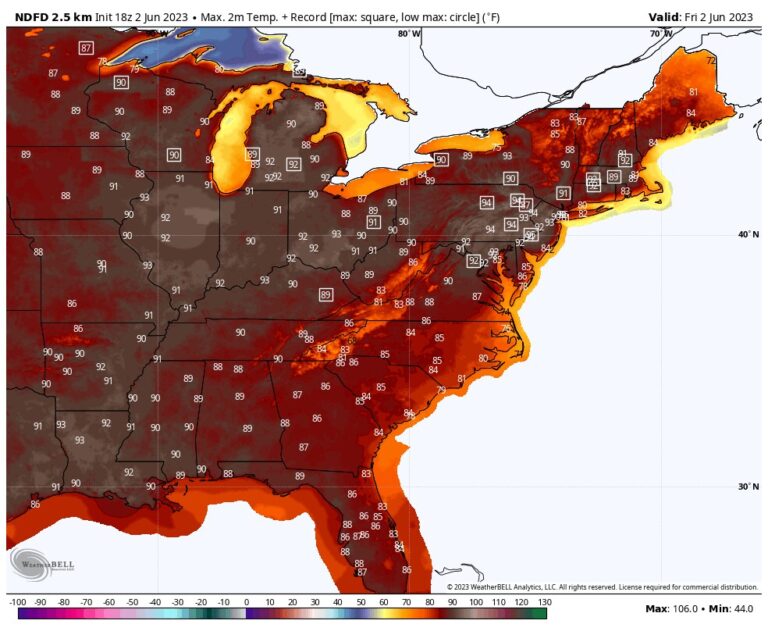As temperatures soared near or above 90 degrees Thursday and Friday, in some cases tying or setting records for the day, more than 100 Detroit public schools closed three hours early. Public schools in Grand Rapids, Mich., closed all day Thursday and Friday because of the heat. Elsewhere in Michigan, public schools at Pontiac, Southfield and Hudsonville they were also closed on Friday.
When it gets hot in classrooms in Detroit, students start having problems with asthma and nosebleeds, and the environment becomes difficult to learn in, said Lakia Wilson-Lumpkins, president of the Detroit Federation of Teachers, the school district's teachers union. More than 50 percent of the district's buildings do not have air conditioning, and some buildings have classrooms without windows, making it difficult for air to circulate.
“Teachers do what they can to comfort the kids in terms of fans and lights out, but it doesn't mean you can attend to an assignment,” Wilson-Lumpkins said.
The school district — which has about 53,000 students — has dismissed earlier because of extreme heat, Wilson-Lumpkins said, and that's happening more often now because of climate change. Some of these old buildings are going to be renovated soon. “So hopefully we'll see some resolution to this situation,” Wilson-Lumpkins said.
In Grand Rapids, the decision to close early because of extreme heat was unusual, said Matthew Marlowe, president of the school district's teachers union, but classrooms are starting to warm up.
When school officials canceled classes, Marlow said, he felt it was the right choice. As in Detroit, some of the older buildings in the area do not have air conditioning. The Grand Rapids school district is in the process of remodeling these older spaces.
Marlowe said the decision by Grand Rapids school officials had little effect on the school calendar, as the district sets aside nine days for inclement weather and had not used them up.
“But in the future, who knows, depending on what happens with these temperatures,” Marlow said.
In addition to schools in Michigan, 40 public schools in Pittsburgh moved to remote learning on Thursday and Friday, according to the Associated Press mentionted. More than a dozen Baltimore City Public Schools and 90 Philadelphia Public Schools closed early Friday. Near the beginning of the school year, schools in Philadelphia closed early two days in late August due to heat, while heat closed schools in Denver for several days in early September.
‼️Good evening DPSCD Families‼️
Please be advised that due to the expected high temperatures tomorrow 6/1 and Friday 6/2, all schools will be dismissed three hours early based on school dismissal time. pic.twitter.com/zT3T5ET2Do
— DPSCommunityDistrict (@Detroitk12) June 1, 2023
Record daily high temperatures Thursday included 92 degrees in Muskegon, Mich. 91 degrees in Marquette, Mich. 91 degrees in Pellston, Mich. 90 degrees in Gaylord, Mich. 96 degrees in Burlington, Vt. 91 degrees in Plattsburgh, NY? 91 degrees in Syracuse, New York. and 93 degrees in both Caribou and Augusta, Maine. Fargo, ND, tied the high for the day at 97 points.
The unusually high temperatures are the result of a large high pressure area providing plenty of sunshine and dry air. Soils that are somewhat dry, due to rainfall deficits of about two to four inches below normal over the past two months, are likely also amplifying the heat. More record highs were expected Friday across parts of the Great Lakes, Midwest and Northeast before temperatures were forecast to dip into the 80s and 70s next week.
Scientists say climate change and urban growth are making summers longer and hotter. The number of days during the school year when the temperature reaches 90 degrees or higher is increasing for many cities in the northern half of the country, according to a Washington Post analysis last year. That has led to about twice the number of canceled days for the heat, according to research by University of Colorado civil engineering professor Paul Chinowsky, rising from an average of three or four pear days a decade ago to six or seven days now.
ONE study of Schools and Global Warming led by Chinowsky found that “more than 13,700 public schools (K-12) in the contiguous US that did not need cooling systems in 1970 have installed or will need to install HVAC systems by 2025″ and that ” more than 13,000 additional schools will need to upgrade their existing HVAC systems due to the need for increased cooling capacity.”
We know it is unacceptable for schools to close early due to lack of AC.
That's why we've invested a record $8.7 billion in K-12 for Maryland public schools to improve infrastructure and ensure every child can receive a world-class public education in a 21st century school.
— Governor Wes Moore (@GovWesMoore) June 2, 2023
The most vulnerable schools tend to be those in urban areas, where buildings tend to be older and temperatures are often warmer. The National Oceanic and Atmospheric Administration has were found that urban centers can be up to 20 degrees warmer than nearby neighborhoods because there are fewer trees, less grass and more pavement to absorb the heat.



